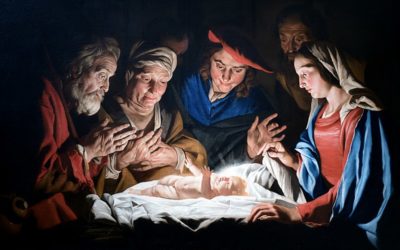In the three days that followed the revelation now known as section 45 of the Doctrine and Covenants, three additional revelations came to bless the new Church and its members. The three additional revelations taught the Saints about spiritual gifts, called a Church Historian, and prepared the gathering Saints for building the New Jerusalem.
Doctrine and Covenants 46
The first of these three revelations was the one now known as section 46 of the Doctrine and Covenants. It helped to correct two problems that had developed in the new Church that was still less than a year old.
The first problem was that some members of the Church had begun excluding nonmembers from the Church’s public meetings. Those who had read the Book of Mormon carefully noted that this practice violated a commandment Jesus had given in 3 Nephi. 18:22. The new revelation confirmed the Book of Mormon commandment in an interesting way. First, it acknowledged that “notwithstanding those things which are written, it always has been given to the elders of my church from the beginning, and ever shall be, to conduct all meetings as they are directed and guided by the Holy Spirit” (verse 2). In other words, in specific situations, the Spirit can guide Church leaders to make exceptions to rules.
But those exceptions should not swallow the general rules, which the Lord laid down as follows:
(1) Don’t “cast any one out from your public meetings, which are held before the world” (verse 3)
(2) Don’t exclude members from sacrament meetings. If a member is unworthy, “let him not partake until he makes reconciliation” (verse 4).
(3) Don’t exclude earnest investigators from sacrament meeting (verse 5).
(4) Don’t exclude earnest investigators from confirmation meetings either (verse 6).
The second problem that had crept into the Church and needed correction was overzealousness for spirituality that led to bizarre behavior. Some Church members began to claim the Spirit was guiding them to behave like animals or otherwise act strangely. In the revelation, the Lord gave the Saints guidance to avoid “being seduced by evil spirits, or doctrines of devils” (verse 7). The guidance included the common-sense doctrine that spiritual gifts have a purpose. “Seek ye earnestly the best gifts,” the Lord commanded, “always remembering for what they are given” (verse 8).
In other words, if you feel prompted to get down on the ground and writhe like a snake, you’re probably not being guided by the Spirit because there is no good purpose in that behavior. God gives spiritual gifts for righteous purposes.
He then lists some of the best gifts, adding that everyone receives at least one of them (verses 9–12).
Importantly, the first gift listed is knowing “by the Holy Ghost . . . that Jesus Christ is the Son of God, and that he was crucified for the sins of the world” (verse 13). Also important is the next listed gift, which is “to believe on their words, that they also might have eternal life if they continue faithful” (verse 14).
In other words, some people have testimonies of the Savior and His atonement that seem to border on certainty, They may testify of Him by saying “I know,” Others have not yet achieved that level of certainty but are willing to exercise faith in the testimonies of those who know. Note that those who can say “I believe” (which is an exercise of their agency, or a choice on their part) are promised the same blessings as those who know, “if they continue faithful.”
Verses 15–26 describe other gifts, and verses 27–33 explain that Church leaders will be guided by the Spirit to tell what gifts are really from God, preventing the distortions that had begun to creep up in the new Church among the overzealous in Kirtland.
For additional historical background on this section, click here.
Doctrine and Covenants 47
When the Church was organized on April 6, 1830, the first commandment the Lord gave to its members was “Behold, there shall be a record kept among you” (Doctrine and Covenants 21:1). Oliver Cowdery had served as a scribe for Joseph Smith and along with fellow witness David Whitmer helped to keep records in the new Church. But when Oliver was called as a missionary to the Lamanites, someone else needed to fill the role of recorder.
Joseph Smith called John Whitmer to serve, but like many of us who receive callings, he was reluctant at first. Serving in this new role was not something he really wanted to do, but if it was the Lord’s will, he would comply. He asked for a revelation to confirm that the calling was God’s will, and the result was what is now section 47 of the Doctrine and Covenants.
In this new revelation, given around March 8, 1831, the Lord said it was “expedient” that John “should write and keep a regular history, and assist you, my servant Joseph, in transcribing all things which shall be given you, until he is called to further duties” (verse 1). John accepted this calling and wrote a history that has been published as part of the Joseph Smith Papers. To see the history and read more about its historical background, click here.
But that was not John’s only role. As Church Historian, he was also responsible to “lift up his voice in meetings, whenever it shall be expedient” (verse 2). Sometimes it is helpful for Church leaders to know about the history of the Church as they make decisions, and the Church Historian has the responsibility to provide accurate historical information for that purpose.
Verse 3 explained that the Church Historian was “to keep the church record and history continually,” meaning without ceasing. In other words, writing Church history is not a one-time task to be fulfilled. It is a continual duty.
Finally, like the ancient writers of the Bible and Book of Mormon, the Church Historian, “inasmuch as he is faithful,” was entitled “by the Comforter, to write these things” (verse 4). In other words, John Whitmer and all subsequent Church Historians were entitled to write sacred history, not just secular history.
The work of the Church Historian and his staff continues to the present day. For more about the Church’s history-keeping functions, check out the Church’s official history website and the many resources it provides.
Doctrine and Covenants 48
After the Lord gave the Saints a commandment to gather to Ohio (sections 37:1–3; 45:64), converts began to flock to that location. On March 10, 1831, the Lord gave Joseph Smith direction on where to settle the gathering Saints. In this revelation, the Lord said the Ohio Saints should stay where they were (verse 1), share their lands with Saints flowing in from the eastern United States (verse 2), and have the newcomers purchase more land for settlement to the extent they had means to do so (verse 3).
But none of this was meant to be permanent. Instead, the Lord’s plan was that they were to build “the city” (verse 4), meaning the New Jerusalem, or Zion.
“The place” for this new city “is not yet to be revealed,” the Lord told Joseph, “but after your brethren come from the east there are to be certain men appointed, and to them it shall be given to know the place, or to them it shall be revealed. And they shall be appointed to purchase the lands, and to make a commencement to lay the foundation of the city” (verses 5–6).
Once the location of the New Jerusalem was revealed, the Lord said, “then shall ye begin to be gathered with your families, every man according to his family, according to his circumstances, and as is appointed to him by the presidency and the bishop of the church, according to the laws and commandments which ye have received, and which ye shall hereafter receive” (verse 6).
This was a very exciting prospect, the chance to build a city of Zion as Enoch did, and the Saints looked forward to the day when the city’s location would be revealed.
For more historical background on this revelation, click here.
Credit for photo at top of post: Detail from William Blake, Enoch, 1806–1807, lithograph, public domain, from https://www.metmuseum.org/art/collection/search/426771 (accessed May 1, 2021).



